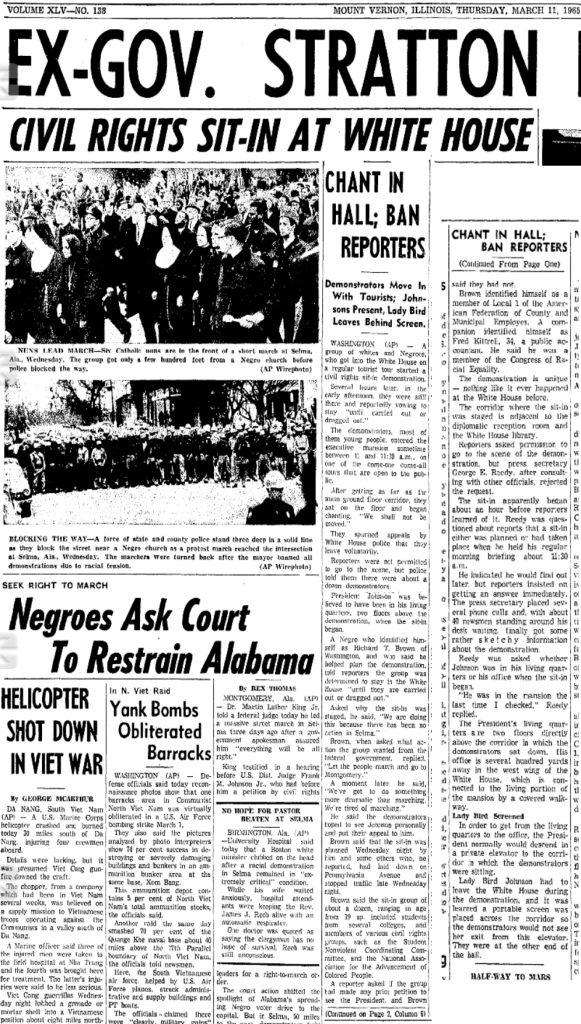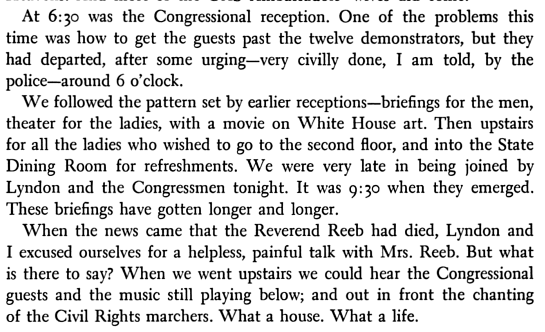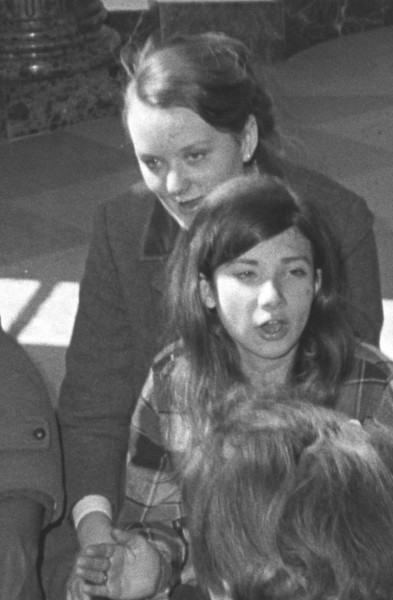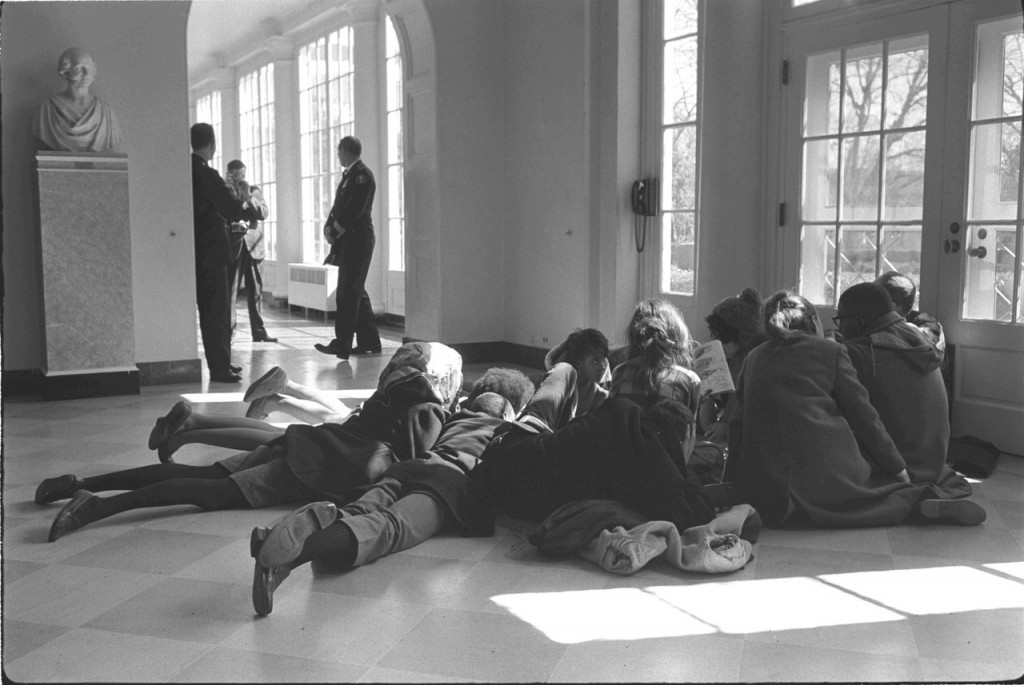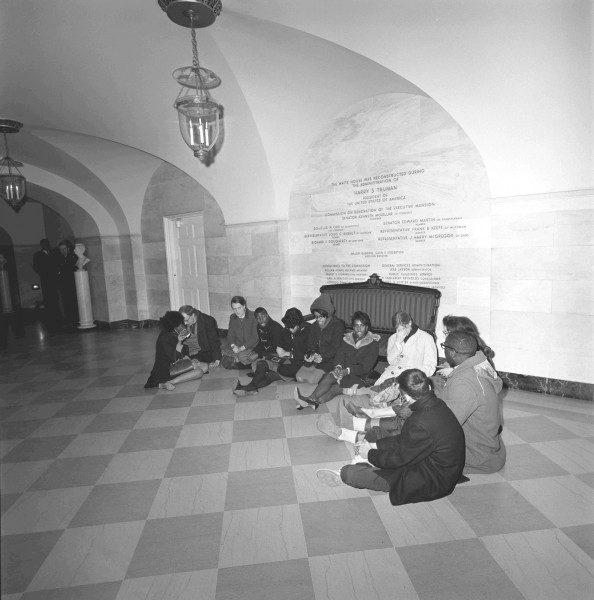From the front page of the Mt Vernon Register News, Thursday, March 11, 1965:
Category Archives: Public Work
Lady Bird Johnson: “I would have loved to have a peek”
Here’s how “Lady Bird” Johnson, the First Lady, described the day in her official diary:
New York Times: “Sitdown Inside White House Protests Selma”
The protest was reported on the front page of the New York Times: “Sitdown Inside White House Protests Selma; Police Eject Youths — Pickets Continue March Outside”
White House Logs From Sit-In
The LBJ Presidential Library has released copies of the official White House diary kept during the Johnson administration.
The entry for March 11, 1965 contains multiple entries regarding the sit-in, many of which feature Rufus Youngblood, a US Secret Service agent who had leapt to protect Johnson during the assassination of JFK, and was put in charge of the White House Secret Service detail when Johnson became President. The log also notes the involvement of Presidential advisors Bill Moyers, Jack Valenti, Cliff Alexander, and Lee White in the discussions that day.
11:20 Rufus Youngblood, USSS, went to the second floor to see the President. He was on the telephone, so he sent a note into the President by way of Ken Gaddis to the effect that 12 demonstrators were sitting down on the ground floor.
White House Photos of Sit-In
The Johnson administration excluded any media from the area of Sheila’s March 11, 1965 sit-in at the White House, so the only photo we’ve found of the protest inside the White House comes from the archives of Johnson’s Presidential Library:
— From “March 11, 1965. Twelve protestors stage a sit-in demonstration at the White House in relation to civil rights.” posted to “LBJ Time Machine“, a Tumblr run by the LBJ Presidential Library
Sheila’s partially obscured but still recognizable in the center back of the group:
Update: The LBJ Library posted a second picture from a different angle:
Second Update: Another area of the LBJ Library’s web site has these in higher resolution, and adds a third photo, taken before the other two, while they were still sitting in the Center Hall outside of the library.
Here’s a close-up of Sheila:
There must be more photographs from this sequence in their archive.
March 11, 1965: White House Sit-In
Selma
On March 7, 1965, “Bloody Sunday”, peaceful marchers calling for voting rights were brutally beaten by state and local police in Selma, Alabama as they attempted to march to the state capitol, Montgomery. (See “Selma to Montgomery marches” in Wikipedia for more.)
Photos and recordings of the violence were distributed to the national media:
Soon after the attack, journalists who were on the scene disseminated pictures and accounts of the brutality to a stunned nation. ABC TV even interrupted its evening movie with a special news bulletin that included fifteen minutes of video footage from the assault in Selma. The following day, the front pages of newspapers were filled with images and stories of the violence against those petitioning for equal voting rights. The confrontation, made especially salient by its vivid visual depiction, became a symbol of Southern efforts to maintain white supremacy at all costs. Writers called the day “Bloody Sunday,” and the bloodshed made many Americans feel shame and disgrace. Overwhelming numbers of citizens expressed shock that such an outrage could happen in the United States: The violence stirred the nation’s conscience and made a deeper impression than perhaps any demonstration during the civil rights movement.
— From “LBJ, ‘We Shall Overcome’“, an essay by historian Garth E. Pauley at Calvin College.
In the furor that followed, civil rights advocates called for President Johnson to take action to protect the marchers from the police.
The Sit-In
On Thursday, March 11, Sheila participated in the first ever sit-in at the White House, going on the official tour with eleven other youngsters, then sitting down when they reached the East Hall and signing “We Shall Not Be Moved”.
The administration excluded any media from the area of the sit-in, so the only photos we’ve found of the protest inside the White House come from the archives of Johnson’s Presidential Library:
The protestors said they would not leave until they had a chance to speak with the President about Selma.
The administration was initially uncertain how to respond, but after seven hours, the remaining protestors were arrested and dragged out by police.
The White House log shows that the sit-in was a frequent topic of conversation for the President that day, and that the order to remove the protestors was given by Johnson himself at 5:00. (See White House Logs From Sit-In.)
Timeline and Locations
The plan for the sit in was formulated in the afternoon or evening of the previous day, March 10.
On the morning of March 11, the protestors met that morning at the Fellowship Hall of St. John’s church, located a block away from the White House.
They then walked to the tourist entrance and entered separately. They had not previously gone on the tour or selected a spot to sit. They went most of the way through the tour and then spontaneously chose a location to sit down.
They first sat down in the East end of the Center Hall on the Ground Floor, outside the Library and Vermeil Room, at around 11:15 AM. (This spot is sometimes labeled the East Hall, but usually the entire area is referred to as the Center Hall.)
At around 1:15, they moved to the next room over, the East Garden Room, and stayed there until they were arrested. (A succinct timeline of events is provided in the Appeals Court ruling issued a year later regarding their case.)
An overhead view illustrating these locations was included in the New York Time’s report on the protest, and you can see them in the map for the current White House tours, which follow a different path than they did at the time, but generally go through the same areas:
You can view this area of the White House in Google Maps, which also hosts a panoramic walk-through of the Center Hall and the East Garden Room, which have not changed much in the intervening 48 years.
Protestors
There were twelve protestors in the initial group that sat down in the White House around 11:15. Two of them left during the course of the afternoon, while the remaining ten were removed by the police around 6:15. The names of the seven arrested protestors charged as adults were released to the press, while three minors were not named in police reports.
For many of the protestors, we only know the details included in those initial reports, typically age, race, and school or hometown. Piecing those together, along with some additional research, reveals the following information about the protestors:
Arrested and charged as adults:
- David Hunt Whittlesey, 21, male, White, Washington DC. (David now lives in Vancouver, and has remained involved in progressive politics, speaking at recent events in support of the Cuban Five and Bradley Manning.)
- Robert Edward Wooten, male, Black, Washington. (This may or may not be the same Ed Wooten who died on February 7, 2010 in Georgia.)
- Jessie Winifred McQueen, 21 (or 22), female, Black, Howard University, Washington DC, a native of Neptune NJ, charged at police station nearest to White House. (Here’s a picture of Jessie and Marta at the police station that night.)
- Marta Carole Kusic (sometimes reported as “Maria” or “Martha”, or “Kasic”), 18, female, White, Howard University, born in Brooklyn, NY, charged at police station nearest to White House. (Marta worked at “the RAT”, an underground newspaper, in 1968.)
- Pamela C. Haynes (or “Pam”), 22, female, Black, Washington DC. (Here’s a picture of Pamela, Sheila, and Carol speaking with a lawyer later that night.)
- Sheila Patricia Ryan, 20, female, White, Catholic University, from Braintree, MA, born in Oxnard CA. (Sheila’s life is covered in detail elsewhere on this site.)
- Carol Lawson, 20, female, Black, from the Bronx, NY. (Carol had worked on a literacy project in Selma in 1964, and was one of four SNCC members beaten at a Selma drive-in on July 4, 1964. She later married and changed her name to Carol Lawson-Green. Her life served as inspiration for “Night Catches Us“, a movie about former members of the the Black Power movement.
Arrested as minors:
- Lynn Wells, 16, female, from Garrett Park, MD, a high school student; not identified by the police because she’s a minor but mentioned in one article as a spokesperson and leader of the protest. (She was charged with a federal felony and received juvenile probation. She was a member of SNCC, and later other civil rights groups. She later married and changed her name to Lynn Wells Rumley. She runs the Textile Heritage Center at Cooleemee and serves as the town mayor.)
- Two other teenage girls whose names we have not been able to learn, one white and one black, both under 18, one of whom may have not been charged.
Left mid-day:
- Barry Wells, 14, male, White. Younger brother of Lynn Wells. Seen in this photograph outside the White House shortly before the others remaining inside were arrested.
- Eugene Harrison (known as “Rick”), male, Black, Washington DC. Identified at the time as affiliated with Howard University, but the Wells report he was still in High School. Spoke briefly outside the protest, said he’d been part of the original group.
In the crowd outside:
- Richard T. Brown, Washington DC, member Local 1 of the American Federation of Country and Municipal Employees, spoke outside the protest, In one press report Brown said he had intended to join the White House sit-in “but I got here late.” (Waterloo Daily Courier Thursday, March 11, 1965, Page 1.)
- A teenager who identified himself as “Chico” was photographed outside the White House and claimed to have been part of the protest group but does not appear in the photograph from inside the White House and was not recognized by the either of the Wells.
News Coverage
The sit-down was nationwide front-page news the next day, including the following:
- New York Times
- Pittsburgh Post-Gazette
- Charleston Gazette (West Virginia)
- Press Telegram
- Boston Globe
Political Aftermath
The sit-in on Thursday, March 11 was part of an overall wave of pressure that led LBJ’s to order a Federal response on Saturday, March 13:
Your Government, at my direction, asked the Federal court in Alabama to order the law officials of Alabama not to interfere with American citizens who are peacefully demonstrating for their constitutional rights.
— From March 13 speech by President Johnson, archived at the LBJ Presidential Library.
In his speech to Congress on Monday, March 15, he proposed the legislation that became the Voting Rights Act of 1965:
The president was aware of the presence of the Lafayette Park protestors and especially those who staged a sit-in on the floor of the White House. As he introduced his proposed voting rights act to Congress on March 15, 1965, he praised the protestors from across the nation, thousands of whom were not far from his doorstep at the time.
— From “Citizen’s Soapbox, A History of Protest in Presidents Park“, at WhiteHouseHistory.org, operated by The White House Historical Association.
Two weeks later, with the protection of a federal court order and the federalized Alabama National Guard, the voting-rights protestors were able to proceed with their march from Selma to Montgomery.
Blocking Future Protests
However, while facilitating the protests in Selma, Johnson wanted to rule out changes of further sit-ins at the White House.
The AP reported that he’d ordered that any future protestors should be removed promptly by the police. (See Press Telegram: “Dragged from the Executive Mansion”)
In the same speech he gave calling for voting rights, he also signaled that protest would need to be governed by limits:
We must preserve the right of free speech and the right of free assembly. But the right of free speech does not carry with it–as has been said–the right to holler fire in a crowded theatre. We must preserve the right to free assembly. But free assembly does not carry with it the right to block public thoroughfares to traffic. We do have a right to protest. And a right to march under conditions that do not infringe the Constitutional rights of our neighbors. And I intend to protect all those rights as long as I am permitted to serve in this office.
— From the “We Shall Overcome” speech by President Johnson before Congress, March 15, 1965.
Legal Outcome
All seven protestors who were over 18 when arrested were convicted and sentenced to six months in jail. (At least two of the three arrested minors were also charged; one reports that she received juvenile probation for her Federal felony charge.)
Over the course of the next year, the case of the seven protestors was appealed, but the appeal was denied.
Sheila entered the Women’s House of Detention in the summer of 1967 and remained there until early 1968, where she was an uncooperative prisoner.
1964: Mississippi Freedom Summer
In the summer of 1964, Sheila travelled to Mississippi as part of the “Freedom Summer” efforts to help organize blacks and challenge the restrictions that prohibited them from voting.
She wanted to spend the full summer there, but due to her parents’ concern, was limited to a shorter trip, probably under the auspices of SNCC.
She spent her time there traveling to small towns in the midst of intense racial tension. On June 21, three other young white northern organizers were murdered by a local posse.
During this time, Sheila travelled with the Deacons for Defense and Justice, an armed political black self-defence group.
On a few occasions, Sheila mentioned a story from this time of driving around back roads in rural Mississippi in a car full of Deacons, young black men carrying guns, and being followed by another car, filled with armed white men; the Deacons urged Sheila to duck her head down, for fear that if the other car had noticed that a white girl was riding with them, it might have resulted in a confrontation and shoot-out.
Working with SNCC
While in D.C., Sheila became involved with SNCC, the Student Non-Violent Coordinating Committee.
She answered phones and did organizing work in SNCC’s Washington office, which introduced her to a number of influential civil rights activists, including Stokely Carmichael, Marion Barry, and Julian Bond.
She had nice things to say about working with Stokely Carmichael at SNCC, although when they met at a conference in Baghdad decades later, she was disappointed by his political thinking about the Middle East.
(Less pleasantly, she also reported an incident in which Marion Barry made unwanted advances towards her, but she was able to fend him off by running to the other side of the office.)
1963: Protests in Cambridge, Maryland
The first important political event Sheila was involved with was the Cambridge, Maryland demonstrations in the summer of 1963.
For background on the protests and race riots in Cambridge take a look at this summary, or read an oral history on a movement web site.
As George tells the story:
Her first demonstration was in Cambridge and the demonstrators were blocked at a place where the main town road passed over from the black to white areas. It was the main downtown store-lined street, I think it’s mentioned in the press’s articles. They were blocked by national guard, and during one or more of the daily confrontations they had their bayonets out. She joked that she got a slight cut on her chest from a bayonet and I’m sure the story was correct.
She went with a group from the Christian Brothers at Catholic University. And she stayed for some time, put up by an elderly black women who looked out for her.
At the first demonstration the guard used teargas. The demonstrators and in particular the Christian Brothers she was with chanted something like we will not be moved and she wasn’t; we says she just sat there with gas all around and when she looked about discovered that all the demonstrators and in particular the Brothers were gone.
Later the Brothers went back to Catholic University, bunt she stayed and was put up in the house I mentioned above. When we drove through the town several years ago, she showed me the building where the demonstrators meet each day. Also, she said she went to church most days (I think she talked to god about what she was doing).
Joining the Civil Rights Movement
While Sheila was attending Catholic University in Washington D.C., she became involved in the Civil Rights movement, an experience that radicalized her politically, and led to a decades-long period of left-wing political work.
She participated in a series of demonstrations and other political activities in Cambridge, Maryland during the summer of 1963.
Around this time she also got involved with SNCC, the Student Non-Violent Coordinating Committee and later participated in the Mississippi Freedom Summer voting rights drive.
